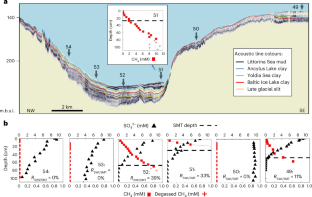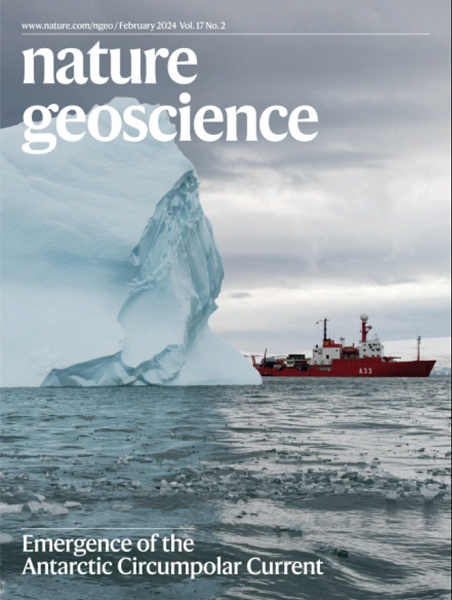Methane leakage through the sulfate–methane transition zone of the Baltic seabed
IF 16.1
1区 地球科学
Q1 GEOSCIENCES, MULTIDISCIPLINARY
引用次数: 0
Abstract
Anaerobic oxidation of methane at the sulfate–methane transition in marine sediments is generally considered to be a near-perfect barrier against methane release from the seabed, but the mechanisms involved are not well understood. On the basis of a survey of Baltic Sea sediments we show that a highly variable amount (0–100%) of subseafloor methane leaks through the sulfate–methane transition. The diffusive methane flux to the sediment–water interface is often high, reaching over 2 mmol m−2 d−1. Even though anaerobic methane oxidation is thermodynamically and kinetically favoured where methane fluxes are high, there is no evidence of methane oxidation in concentration, isotope and modelling results. Cores that lacked anaerobic methane oxidation had high modelled organic matter mineralization rates, suggesting that a possible mechanism could be high electron donor availability due to elevated H2 concentrations, as has been predicted by laboratory studies. We show that methane leakage across the sulfate–methane transition is widespread in organic-rich marine sediments. Inhibition of anaerobic methane oxidation in organic-rich marine sediments causes widespread methane leakage from the seabed, according to an analysis of sediment cores from the Baltic Sea.


波罗的海海底硫酸盐-甲烷过渡带的甲烷泄漏
海洋沉积物中硫酸盐-甲烷转化过程中甲烷的厌氧氧化通常被认为是防止海底甲烷释放的近乎完美的屏障,但所涉及的机制尚不清楚。根据对波罗的海沉积物的调查,我们表明海底甲烷通过硫酸盐-甲烷转变泄漏的量是高度可变的(0-100%)。扩散到沉积物-水界面的甲烷通量通常很高,可达2 mmol m−2 d−1以上。尽管甲烷通量高的地方在热力学和动力学上有利于厌氧甲烷氧化,但在浓度、同位素和模拟结果中没有甲烷氧化的证据。缺乏厌氧甲烷氧化的岩心具有较高的模拟有机质矿化率,这表明可能的机制可能是由于H2浓度升高导致的高电子供体可用性,正如实验室研究预测的那样。研究表明,在富有机质的海洋沉积物中,硫酸盐-甲烷转变过程中的甲烷泄漏是普遍存在的。
本文章由计算机程序翻译,如有差异,请以英文原文为准。
求助全文
约1分钟内获得全文
求助全文
来源期刊

Nature Geoscience
地学-地球科学综合
CiteScore
26.70
自引率
1.60%
发文量
187
审稿时长
3.3 months
期刊介绍:
Nature Geoscience is a monthly interdisciplinary journal that gathers top-tier research spanning Earth Sciences and related fields.
The journal covers all geoscience disciplines, including fieldwork, modeling, and theoretical studies.
Topics include atmospheric science, biogeochemistry, climate science, geobiology, geochemistry, geoinformatics, remote sensing, geology, geomagnetism, paleomagnetism, geomorphology, geophysics, glaciology, hydrology, limnology, mineralogy, oceanography, paleontology, paleoclimatology, paleoceanography, petrology, planetary science, seismology, space physics, tectonics, and volcanology.
Nature Geoscience upholds its commitment to publishing significant, high-quality Earth Sciences research through fair, rapid, and rigorous peer review, overseen by a team of full-time professional editors.
 求助内容:
求助内容: 应助结果提醒方式:
应助结果提醒方式:


